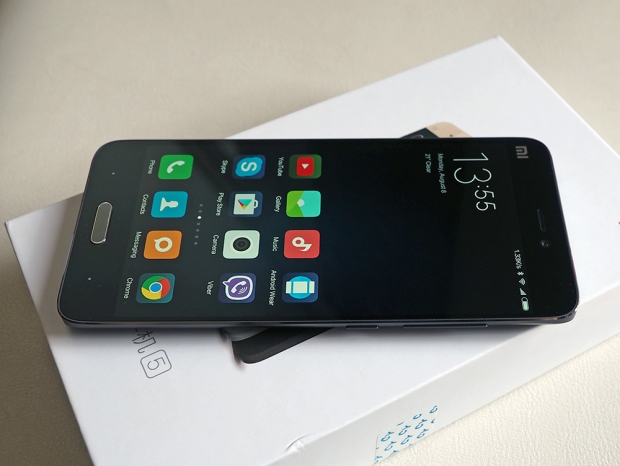Index
Review: Snapdragon 820 on a budget
Xiaomi’s new flagship is late to the party. The Mi4 launched in 2014, and the Chinese brand did not bother launching a successor in 2015. Why? Because it didn’t have a proper processor to build it around. The Mi4 was based on the Snapdragon 801, so with the Mi5, Xiaomi skipped a year, and a CPU generation.
Instead of launching an outright replacement for the Mi4, Xiaomi went about introducing a few new models, including the mid-range Mi4C, a Snapdragon 808 device with an exceptional price tag, followed by a bevvy of budget Redmi models.
So, was the Mi5 worth the wait?
In most respects, yes, yes it was. The Mi5 is based on Qualcomm’s Snapdragon 820 processor, which hardly needs an introduction. In other words, performance should not be an issue. What’s more, Xiaomi ditched the 16GB entry-level version, so the new flagship is available in 32GB, 64GB and 128GB flavours. The differences don’t end there. The 32GB version ships with 3GB of RAM and an underclocked processor, the 64GB variant has a higher-clocked processor and 3GB of RAM, while the top tier 128GB model boasts 4GB of RAM.
The rest of the package is identical. You get a 5.15-inch 1080p display with very small bezels, a 16-megapixel camera based on a Sony sensor, with 4-axis optical image stabilization (OIS), 3000mAh battery, support for Qualcomm Quick Charge 3.0 technology, along with a bunch of other goodies. NFC also mede its debut in the Mi5, and it was about time, since Xiaomi ignored NFC technology for years.

The design borrows from the old Mi4, but also includes a few new details, such as a physical home button with an integrated fingerprint scanner. That’s another first for Xiaomi. The design isn’t is colourful and relaxed as most Xiaomi phones, but it’s in line with what we expect from Mi-series flagships.
The lines are simple and elegant. A slab of Gorilla Glass 4 on the front, flanked by a metal frame, with a curved glass battery cover at the back. The curved sides help create the illusion of a thinner device, but at 7.3mm, the Mi5 is already quite thin. It’s light too, tipping the scales at a mere 129g.
Prices start at about $350 for the 32GB version. The faster, 64GB version we tested is selling for $415 at Gearbest which is still a great deal. Sounds like a nice deal, so let’s take a closer look.
Design and Build Quality
So, the Mi5 is thinner and lighter than its predecessor, and it’s even lighter than the iPhone 6S, but what about its footprint? Surely, a bigger 5.15-inch display will result in a somewhat bigger device.
Not quite. The phone is 69.2mm wide and 144.6mm tall, which means it’s as wide as an average 5-incher, but the curved sides make it feel even more compact.
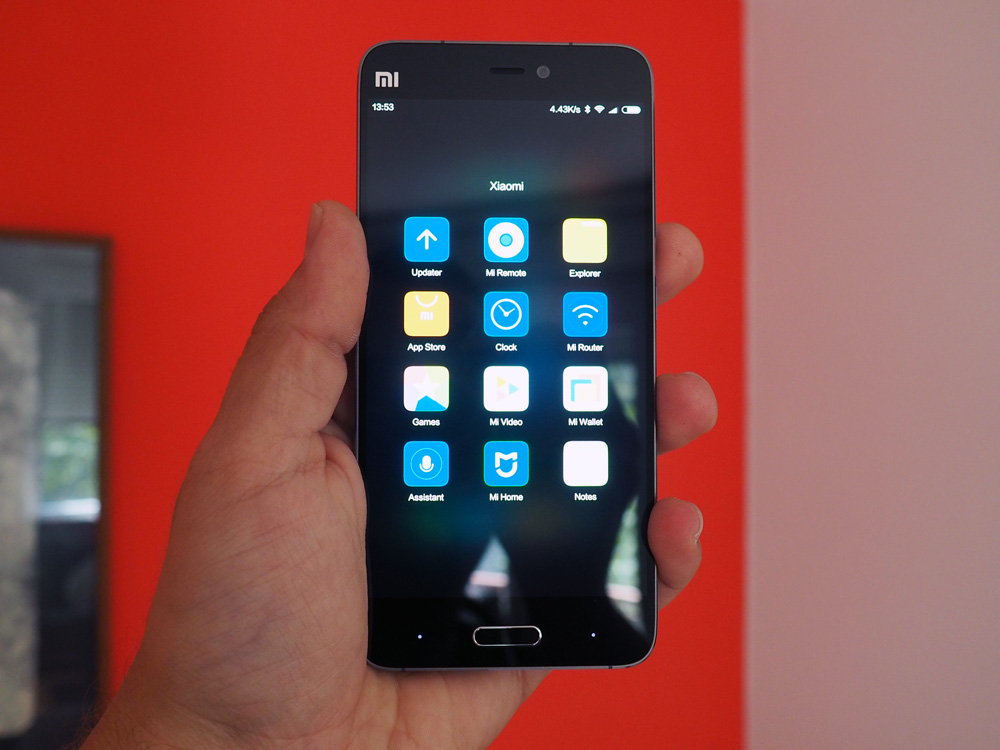
It’s 5mm taller than Xiaomi’s previous 5-inch designs, but this is hardly a big deal.
The glass is not curved, and if you place it face down, it’s protected by the alloy frame.
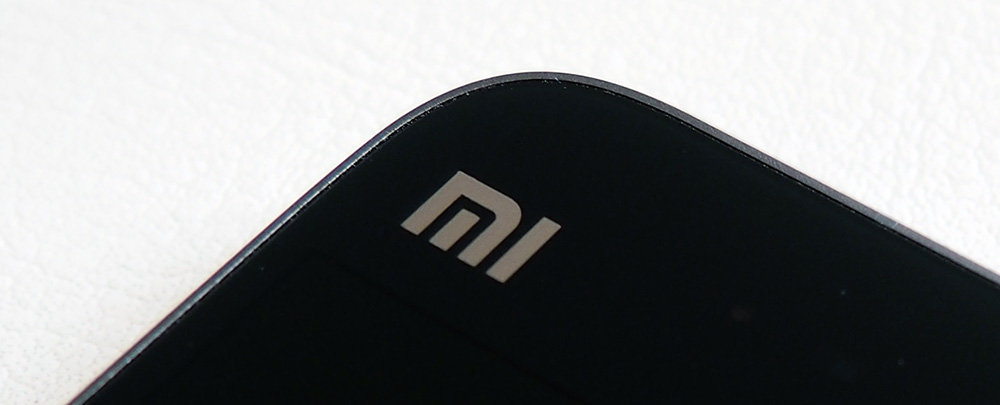
The sides are CNC-machined alloy. This is not a unibody design, as the glass back is removable, although you need a suction cap to pry it off. Xiaomi refers to the glass on the back as “3D Glass.” Before you start complaining that the back design is a blatant Samsung ripoff, consider this: Xiaomi used a similar design on Note series products a full year before Samsung adopted it for its Galaxy flagships.
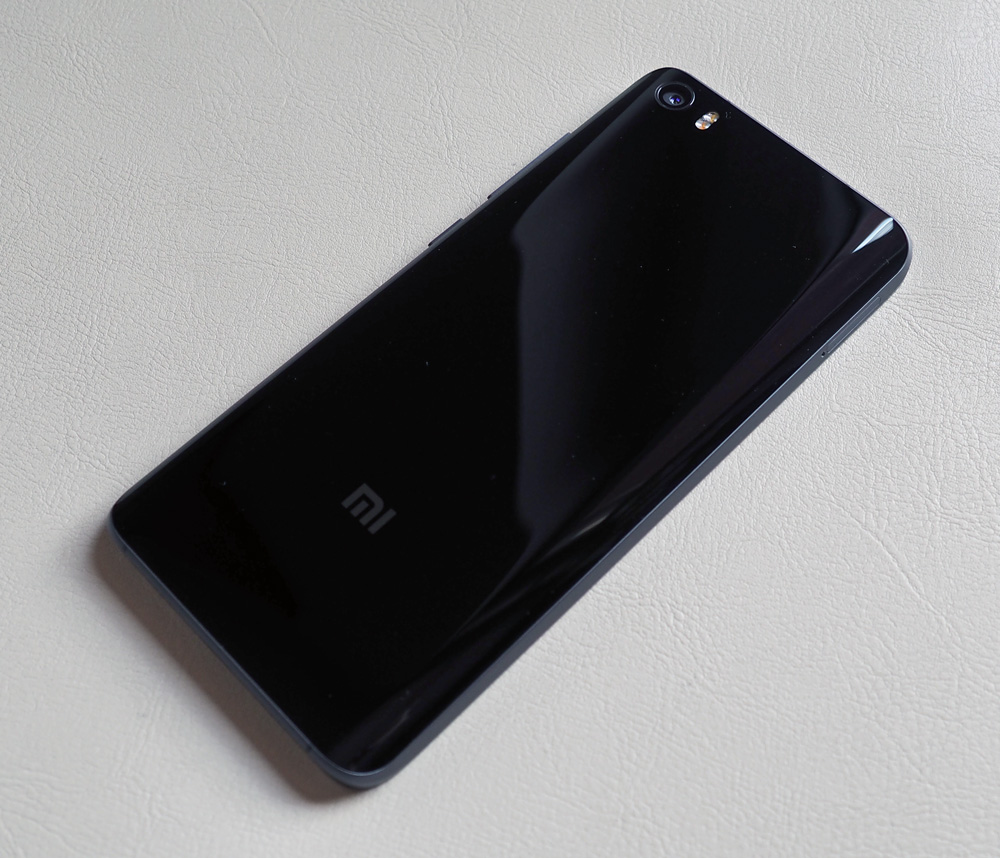
At the bottom, you’ll find a USB Type-C connector and the side firing speaker, with an added decorative grille for symmetry (which also houses the microphone).

The power button and volume rocker are located at the right, as you’d expect.

The SIM slot can accommodate two nano SIM cards, but sadly the Mi5 does not have a microSD slot.
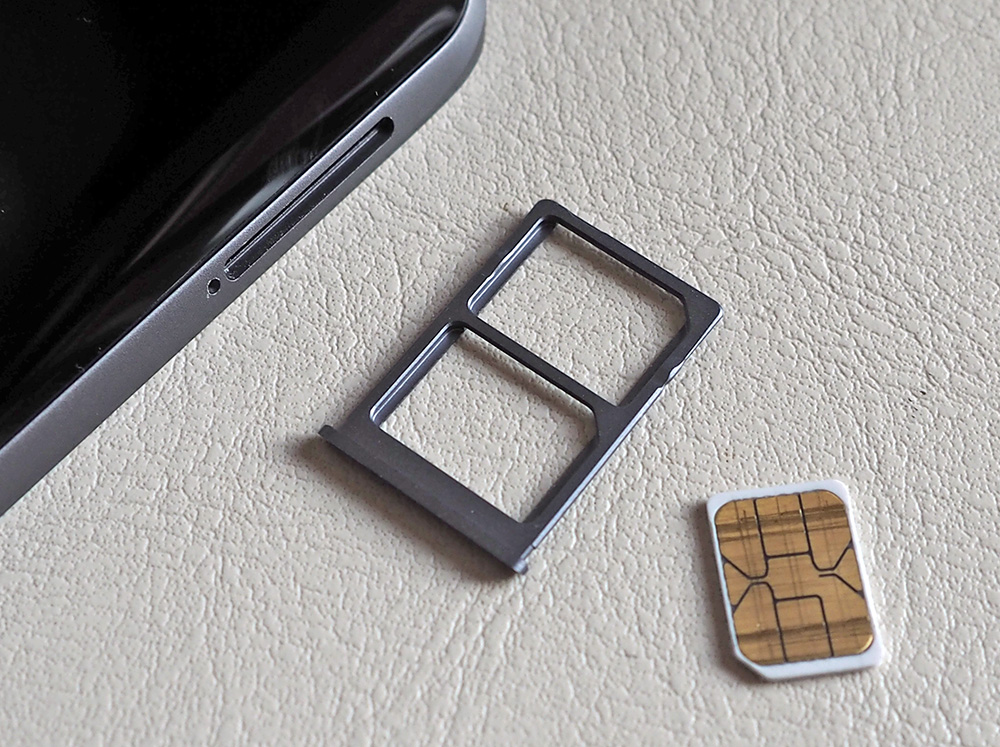
The 3.5mm audio port and IR blaster are located at the top.

The back is minimalism at its best. Curved glass, camera, flash, and the Mi logo. While the battery is not user replaceable, the glass cover can be removed and replaced with relative ease.
Xiaomi Mi5 Specs and Performance
This is where it gets really interesting. On top of the state-of-the-art Qualcomm Snapdragon 820 processor, the Mi5 also boasts fast memory and storage.
The phone relies on LPDDR4 memory and UFS 2.0 storage. If this sounds familiar, we should note that Samsung introduced both technologies in the Galaxy S6. However, Xiaomi did it on a budget, as its flagships tend to cost substantially less than Samsung products. UFS 2.0 storage is up to three time faster than eMMC 5.1 storage, which means it’s practically on a par with SSD drives of yesteryear.
In addition to its Kryo custom CPU cores, the Snapdragon 820 also features Adreno 530 graphics, promising a quantum leap in performance compared to the Mi4.
Let’s take a closer look at the spec sheet.
Xiaomi Mi5 Specs:
- SoC: Qualcomm Snapdragon 820
- CPU: Four 64-bit Qualcomm Kyro CPU cores up to 2.15GHz - 32GB model up to 1.8GHz
- GPU: Adreno 530 up to 624MHz
- RAM: 3GB LPDDR4 (up to 1866MHz)
- Storage: 64GB UFS 2.0 internal storage, not expandable
- Display: 5.15-inch 1080p IPS panel
- OS: Android 6.0 with MIUI 7 on top
- Rear camera: 16-megapixel Sony IMX298 sensor, f/2.0 aperture, PDAF, 4-axis OIS
- Front facing camera: 4-megapixel sensor, 2um pixel size
- Battery: 3000mAh, integrated
- Dimensions: 144.6mm x 69.2mm x 7.3mm
- Weight: 129g
- WiFi and Bluetooth: 802.11b/g/n/ac WiFi and Bluetooth 4.1
- Sensors: ambient light, direction, accelerometer, compass, proximity, GPS, A-GPS
- Other noteworthy features: IR blaster, NFC
- SIM card: dual SIM (nano SIM), dual standby
- Network support:
2G: GSM 850/900/1800/1900MHz
3G: WCDMA 850/9001900/2100MHz
4G: FDD-LTE: 1800/2600MHz, TDD-LTE: B38 / B39 / B40 / B41 (Make sure to check regional compatibility prior to making a purchase)
Despite the fact that prices for the entry-level Mi5 start at about $350, we are looking at a high-end spec. Most of the components are on a par with 2016 flagship phones, although there are some differences.
The Mi5 does not support technologies like wireless charging and Force Touch, but then again, it’s the first Xiaomi smartphone with NFC support. It is also the first Mi with a physical home button, which features an integrated fingerprint scanner. The f/2.0 lens on the main camera feels slightly worse than the optics used on iPhones and Samsung’s latest Galaxy flagships, but 4-axis OIS should go a long way towards improving image quality (especially if you’re into video).
Benchmark results prove that Xiaomi’s latest flagship can hold its own against significantly pricier devices from bigger brands. It’s not just the new Qualcomm processor, however. The Mi5 packs fast RAM and storage, which helps in many situations.

In 3D Mark, the Mi5 manages to outpace the competition, even the HTC 10, which is based on the same processor.
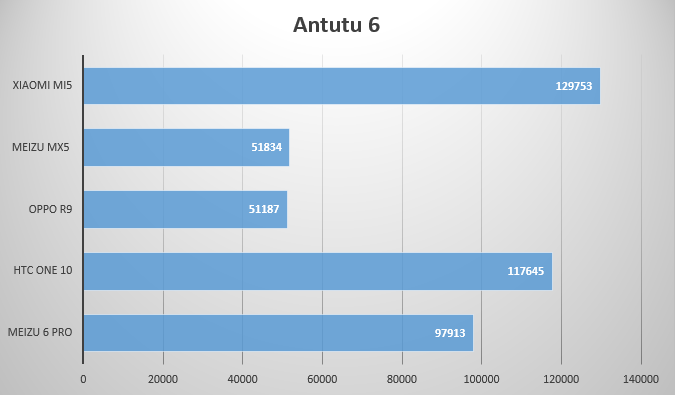
We see similar results in Antutu 6. The performance gap between the Snapdragon 820 and budget Cortex-A53 octa-cores is staggering.
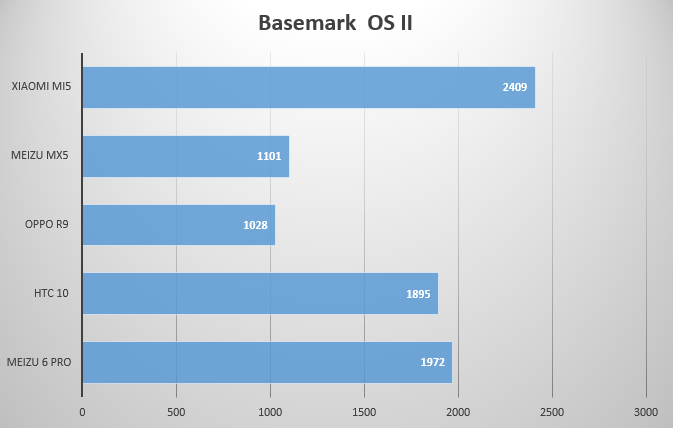
Basemark OS II also delivers good results. This benchmark also takes into account storage speed and a few other factors.
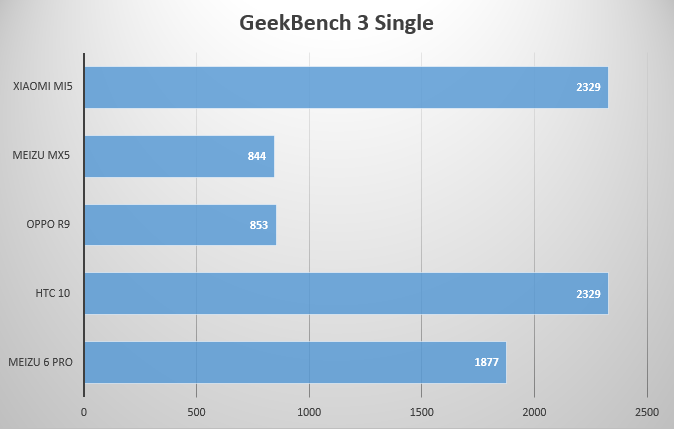
The Geekbench single-core score is identical to the HTC 10.
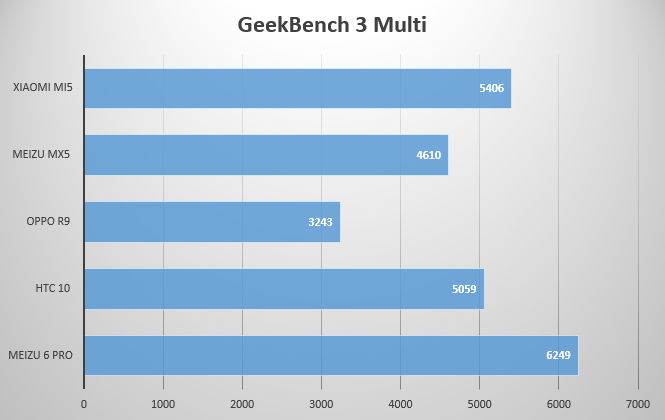
However, in the multi-core test, the Meizu 6 Pro and its many CPU cores pull ahead.

The Mi5 ends up marginally faster than the HTC 10 in PC Mark.
Benchmarks don’t always paint the full picture, so what about the subjective feeling? Well, it’s great. The phone is significantly more responsive than Xiaomi devices based on the Snapdragon 808 and 650, which feature slower RAM and storage.
We have no complaints about GPS performance, either.

Bottom line: in terms of price/performance, the Mi5 is in a league of its own. It delivers as much performance as flagship phones that cost twice as much, which is impressive to say the least.
Audio, Display and Camera Quality
What’s the use of having a lighting-fast processor if it’s mated to a subpar display, or a lousy camera? These are usually the components that get the proverbial “haircut” in cheaper devices.

Luckily, the Mi5 does not compromise quality for price. The phone sports a top-notch 5.15-inch display, rated at 600 nits brightness, with good backlighting and color rendition. It’s not a 4K or 1440p display - Xiaomi opted for a 1080p unit, but there is a silver lining. By choosing a somewhat lower resolution, Xiaomi got a thin display with tiny bezels, good power efficiency, and low weight. That helped keep the phone relatively thin (7.3mm) and light, about 15g lighter than an iPhone, with a 4.7-inch screen. You still end up with 428PPI, which should be more than enough for most users.
On the whole, the display is nothing short of excellent. It’s bright enough to remain legible under the Mediterranean sun, and Xiaomi’s sub-pixel processing helps as well. Like all Xiaomi phones, there’s “Read Mode” as well, which reduces the background glare and color temperature. It’s a nice feature, although it could have been better. We’d like to see the ability to create user profiles, which would activate read mode at a certain time of day. Adaptive brightness works well, and it’s a lot faster and subtler than on previous Xiaomi phones. It can still react aggressively in some situations, but this happens to every smartphone from time to time.
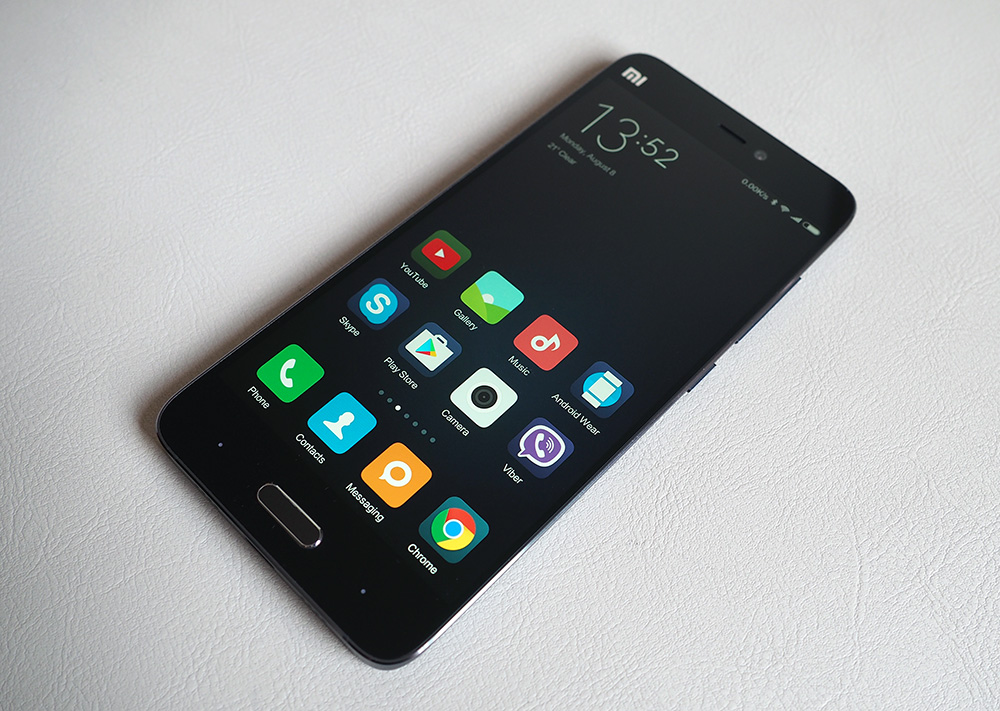
While this may be a 1080p display in an era of 1440p flagships, that does not mean it’s no good. Quite the opposite, it’s an excellent display with above average brightness and contrast. Remember, resolution is not everything - just ask Apple.
The side-firing speaker is quite good, although it’s nothing special. It’s loud enough for the occasional speaker call and does not distort the sound if you’re enjoying video on max volume. While the Mi5 features two sets of speaker grilles, it has just one speaker, located on the left. The right grille houses the microphone.
Call quality is excellent, and noise cancellation works quite well. The Mi5 is also the first Xiaomi phone to support VoLTE, allowing for higher fidelity audio calls.
So what about the cameras?

Let’s start at the back, with the 16-megapixel unit. It’s based on Sony’s IMX298 sensor, with PDAF and DTI pixel-to-pixel isolation. Xiaomi’s trump card is 4-axis optical image stabilization (OIS). While OIS is nothing new on flagship phones, Xiaomi is the first vendor to incorporate 4-axis OIS with longitudinal and latitudinal image stabilization, which means it can detect and compensate motion from 8 different directions. Sounds impressive, and in some situations, Xiaomi’s OIS will help you produce sharp shots that would otherwise be a blurry or grainy mess.
The camera is topped off by layer of protective sapphire glass and does not protrude out of the chassis, which means it’s a bit less likely to be damaged or scratched. Unfortunately, there is a price to pay for the ultrathin design. The Mi5 sports an f/2.0 lens, which doesn’t sound too impressive in this day and age, because flagship phones feature superior optics (for example, the Samsung Galaxy Edge S7 has an f/1.7 less and a bigger sensor with fewer pixels).
This means the Mi5 will consistently underperform in low light, if pitted against the latest Galaxies and iPhones. It has more megapixels on paper, but the individual pixels are smaller. Coupled with the “slower” aperture, the Mi5 gets less light on the sensor and individual pixels. OIS helps (a lot), but it’s no substitute for a bigger sensor and lens.
Now for the good news. Though the camera can’t shoot it out with the likes of the Edge S7 in low light conditions, it delivers excellent results in daylight.

HDR mode works quite well, too. It tends to be subtle, in most situations, although it can go overboard with a lot of back lighting.

HDR ghosting tends to be limited and probably won't affect most shots.
Can 4-axis OIS deliver night panorama shots? Yep, but only if you use Manual mode and go for very long exposures, like 1/4s or 1/2s for panorama shots in low light, at ISO 400. We even managed to pull off some dusk scenery shots with a 1s shutter speed. Here's how a low-ISO 1s shot compares to the Auto mode, which used a shutters speed of 1/14s at ISO 1200.

And here is the 100% crop. The results are good, but you obviously can't use such long exposure times for most shots.

On the other hand, good OIS makes a huge difference in some situations, provided you bother. Sadly, most people just stick to Auto on their phones, and the camera app doesn’t offer any new user-enabled modes optimized to benefit from 4-axis OIS, or the long exposure capability it provides.
Close-up shots also benefit from OIS, as does video. The phone can capture 4K video at 30fps, but if you’re into slow motion, you’ll be happy to hear that the camera can pump out 120fps at 720p. Xiaomi's camera app hasn't changed in a while.
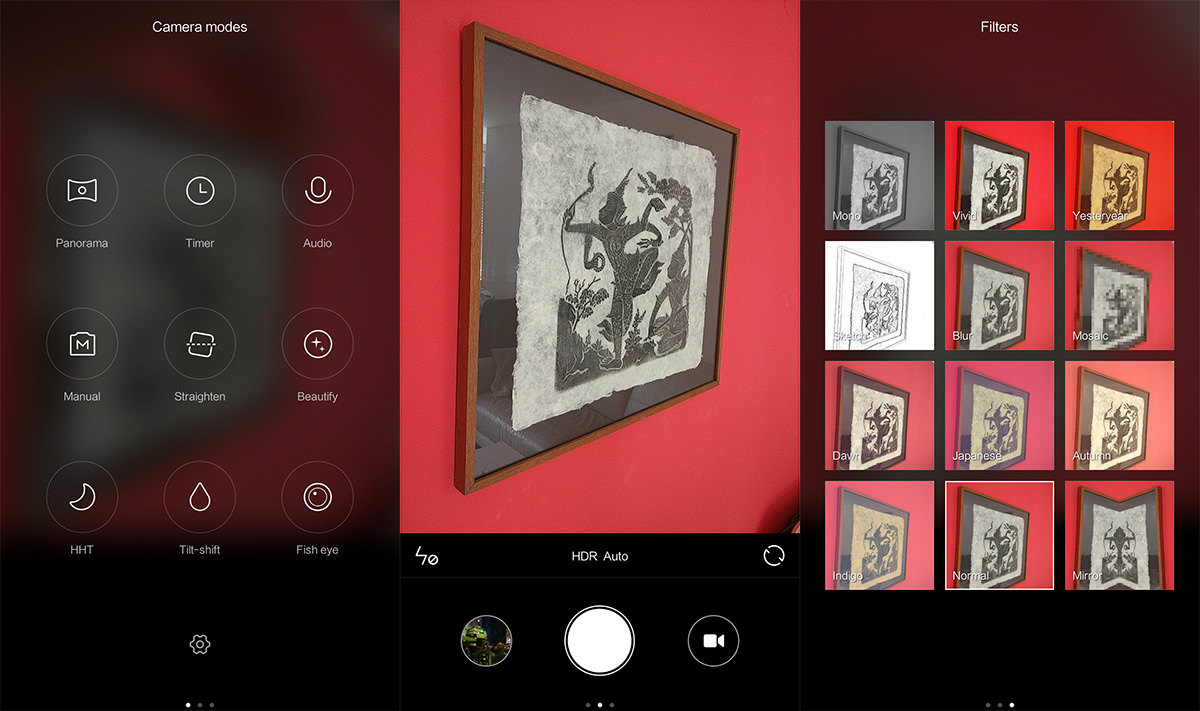
Bottom line: Xiaomi’s camera can’t match Samsung and Apple in low light, but it’s still a very good performer. Bear in mind that the Mi5 costs a lot less than a top of the line Galaxy or iPhone. It would be unfair to expect the Mi5 to consistently deliver results matching products that cost twice as much, or more. Xiaomi obviously decided to save a few pence on the optics, but in doing so, it also saved a bit of room, so the lens does not protrude. This is a matter of personal preference, but people who love phones with a flat back should be ok with this decision.
The front facing camera has a 4-megapixel sensor, which sounds like a step down from the Mi4 generation, but the new sensor is much better. Xiaomi traded megapixels for pixel size, and with thanks to the 2um pixel size and improved optics, the selfie cam delivers much better results than the previous generation.
OS, UI and Everyday Use
The Mi5 is the first Xiaomi phone to ship with Android 6.0. In fact, the company hasn’t updated the rest of its portfolio to Android 6.0 just yet. We currently have two Xiaomi samples lying around our lab (Mi4c and Redmi Note 3 Pro), and neither of them received an Android 6.0 update yet.
However, in the weird world of Xiaomi, Android versions are a bit less relevant than you may think. The company’s elaborate MIUI skin makes the difference between Android 5.1 and 6.0 barely noticeable as far as overall user experience goes.
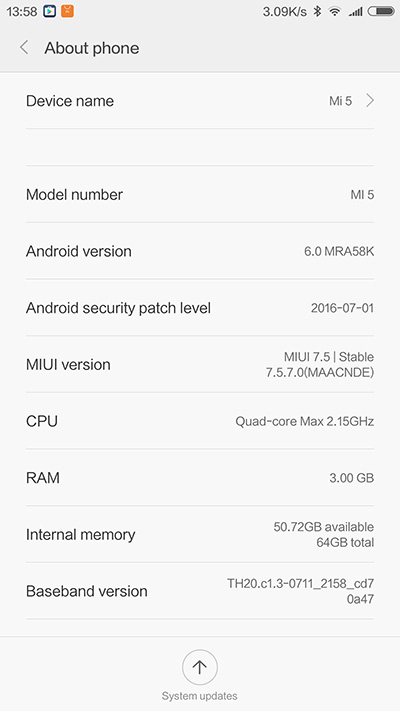
Of course, there are a lot of differences that aren’t skin deep, but realistically, most users would be unable to tell the difference.
Android 6.0 should unlock a few extra features and improve performance in certain situations, but to be honest, it’s not a huge deal.
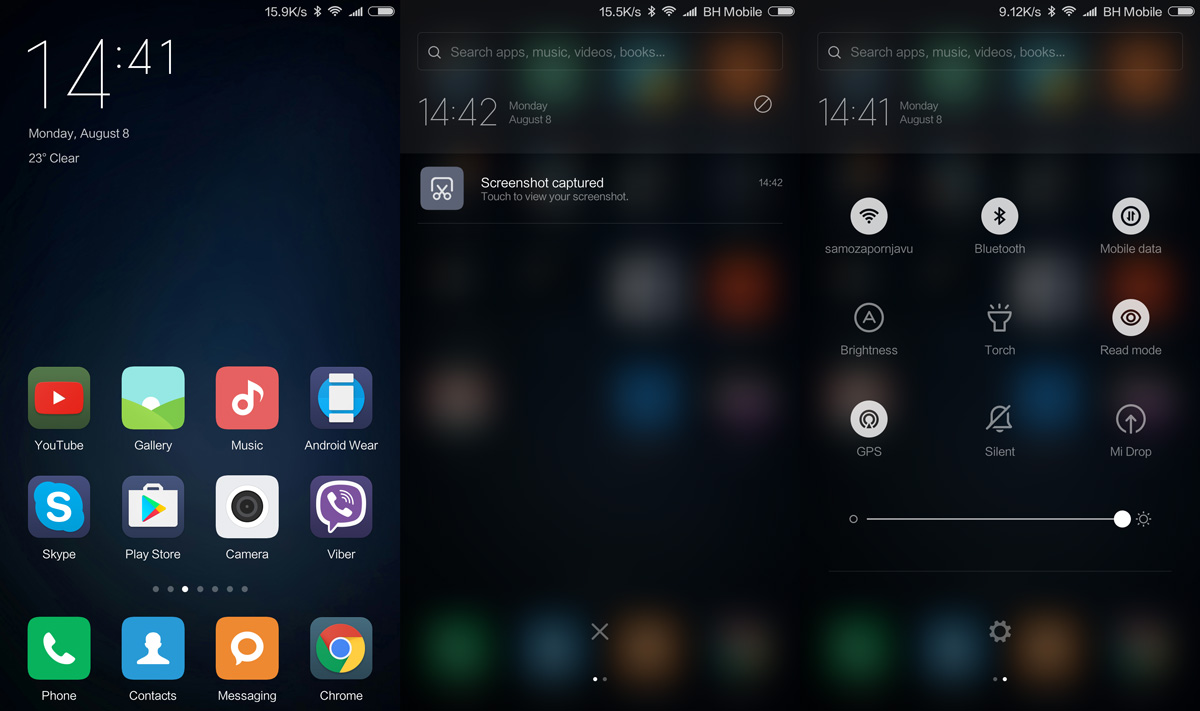
For most users, the MIUI version will be a much bigger deal that the version of Android buried beneath it. We have a love-hate relationship with MIUI, in that it’s gorgeous, customisable and flexible, but at the same time it’s a bit too similar to iOS and new users might have a hard time adjusting to Xiaomi’s UI. What’s more, a lot of services are China-specific, so Western users can’t access them. There are a few annoying aspects of MIUI, such as the inability to expand email notifications or delete emails from the notification drop-down, but these foibles are outweighed by MIUIs look and feel.
MIUI 8 is just around the corner, and the Mi5 will get it first. The new incarnation of MIUI promises to deliver a few new features, including an improved app manager, new core apps, the ability to change the background colour in system apps, new power saving mode, overhauled gallery and a new video editor.
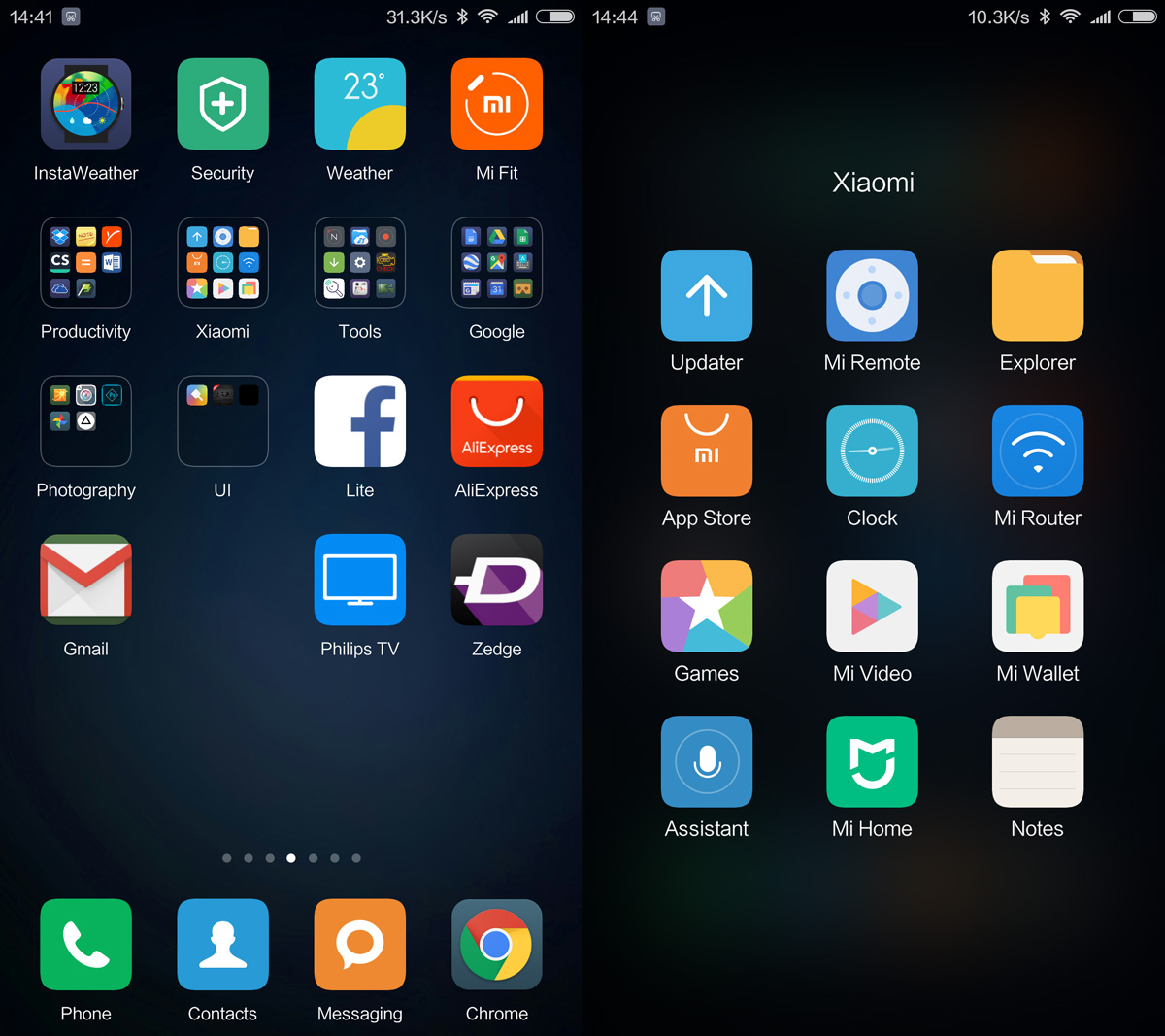
The MIUI user interface hasn’t changed, which means it’s pretty much a hybrid of iOS and Android. It’s one of the best-looking UIs you can get on Android today, but it’s not perfect. We’d like to see more available actions on the notification pane, the menu system can confuse new users because some stuff just isn’t where you’d expect it.
Customization remains MIUIs trump card. Thousands of different themes are available, ranging from absurd gimmicks to professionally designed gems. You can also edit and “mix” themes, so you can use the lock screen from one theme, icons from another, and so on.
The biggest problem with the Mi5’s software isn’t technical, it’s political. Xiaomi decided to lock the bootloader and encrypt the Mi5, which wouldn’t be much of a problem if the company sold its phones in the West. Unfortunately, it does not, so a lot of phones are sourced from resellers and may ship with unofficial ROMs. Many resellers basically take the Chinese ROM, add dozens of languages, and ship the phone worldwide. If you want to move to an official ROM (Chinese or Global), things can be tricky. In the past, Xiaomi phones were flash-friendly and we flashed virtually every Xiaomi phone we reviewed so far - the process would usually take minutes. With the Mi5, you may be forced to contact Xiaomi and apply for a bootloader unlock. Once the request is processed and approved, you should be able to revert to an original ROM, but the process is more complicated and time consuming than it used to be. It also means novice users could be in trouble if they get a phone with a reseller ROM.
Once you’ve got the latest official ROM running, you can proceed to set up services and start enjoying your Mi5. So what’s it like in everyday use?
Pretty good, actually. The low weight, curved sides and thin bezels create an illusion of an even smaller device. The Mi5’s footprint is just a tad bigger than that of the iPhone 6S, yet it’s lighter and has a bigger screen. In fact, the 5-inch Mi4c is a hair thicker and wider than the Mi5, despite the fact that it rocks a smaller display.
Xiaomi’s decision to use a glass back on the Mi5 might not be to everyone’s liking. Yes, having Gorilla Glass 4 on the back should protect the phone from scratches, but glass picks up a lot of fingerprints. While it’s relatively thin, the glass battery cover feels sturdy, although you could be in a world of hurt if you drop the phone. A genuine replacement cover will set you back about $30-$40, and you should have no trouble swapping it out on your own. You can also get third-party covers, which are a tad thicker than the original glass cover. These covers cost a few bucks each, and you can choose all sorts of designs and materials.
It’s clear Xiaomi went out of its way to keep the phone light and compact, so did it sacrifice battery life in the process? Not really. The Mi5 has a 3000mAh battery, which delivers good endurance, on par with other Android flagships, and even better in some respects (thanks to the efficient screen). Quick Charge 3.0 is on board as well, which is great news because the phone can charge to about 80% in under an hour.
We have no complaints about voice call quality and we did not experience any network issues. Support for certain 4G bands is lacking, so you should do your homework prior to making a purchase. The community is already trying to unlock more bands on the Chinese version of the phone, but this is hardly something we’d rely on.

Xiaomi was late to join the fingerprint scanner craze. It’s first phone to feature a fingerprint scanner, the Redmi Note 3, launched earlier this year. The Mi5 is the first Xiaomi handset to feature a fingerprint scanner at the front. The scanner is relatively small and resembles Samsung’s home button. Still, Samsung did sort of rip off Xiaomi Note’s back design, so let’s call it even. The fingerprint scanner is ceramic and the button can be set to go Home after a tap or a press, which is nice because we assume Xiaomi veterans will need some time getting used to it. We just wish Xiaomi would borrow another home button idea from another competitor - Meizu’s home buttons double as the Back and Home button (tap for Back, press button for Home). The fingerprint sensor works like a charm, despite its relatively small size. You can also use it to limit access to certain apps and so on.
If you take the new Home button out of the equation, the Mi5 feels like any Xiaomi phone out there, with one small difference: It’s much faster!
We’re not saying lesser Xiaomi phones are slow, but the Mi5 is in a league of its own. The mighty Snapdragon 820, backed by very fast RAM and storage, delivers exceptional performance, on a par with other Android flagships based on the same processor. However, it costs a lot less than other SD820 phones, which is why people find Xiaomi attractive in the first place - the company has a tradition of delivering good hardware and excellent prices, and the Mi5 is no exception.
Yeah, it’s supposed to be a “budget flagship” but in reality, there’s nothing “budget” about the Mi5. It looks, feels and performs like any big-brand flagship, and, in some respects, it manages to pull ahead of much more expensive phones.
Conclusion
As a value proposition, Xiaomi phones are definitely a great choice, and it’s easy to recommend budget Xiaomi phones like the Mi4c and Redmi Note 3 Pro (SD808 and SD650 processors respectively). These phones retail at about $140 to $160 and they’re bargains, considering the hardware inside.
However, the Mi5 has to live up to flagship expectations. Being cheaper than mainstream flagships isn’t enough in this market segment: You also need great performance and user experience. Luckily, the Mi5 does not disappoint. It delivers exceptional performance and can easily take on mainstream flagships.
What about the f/2.0 camera? In low light conditions, it can’t keep up with the latest flagships, but you can get great results if you decide to fiddle with manual controls and take full advantage of the 4-axis stabilization. While its optics aren’t as good as those used in Samsung and Apple flagships, Xiaomi’s camera is a tad smaller and does not protrude. This may not seem very important, but a lot of people just like phones that don’t have a huge lens sticking out of them.
The locked bootloader is another source of concern, especially if you’re new to Xiaomi phones. Changing the ROM can be tricky and time-consuming, and it’s definitely not something non-geeks should be doing.
Aside from the ROM issues and the optics, the Mi5 is a proper flagship, yet it’s cheaper and more compact than most competing designs. It’s easy to recommend, although the ROM issue is a caveat when it comes to users who aren’t tech-savvy.
So which one should you get? The entry-level 32GB version ships with a marginally slower processor, but you still get the same RAM, fast storage, camera, display etc. It’s relatively good value, provided you can live with 32GB of storage. We tested the 64GB model, which hits the sweet spot. It has a faster processor and enough storage for most people, yet it doesn’t cost much more than the 32GB version. The 128GB model isn’t for everyone. It ships with an extra 1GB of RAM, for a total of 4GB, and loads of storage, but it’s quite pricey and doesn’t deliver much more performance than the 64GB model (or even the 32GB variant for that matter).
Therefore we recommend the 64GB version for most people, although the 32GB model is the obvious choice for cash-strapped consumers. Sure, it has a somewhat slower processor, but honestly, who cares? It’s still a Snapdragon 820 device and it’s still very fast.
To sum up: With the Mi5, Xiaomi is back in the flagship space, after skipping one product cycle. It’s a great comeback, and since Xiaomi prices tend to tumble a few months after launch, chances are the Mi5 will become even more attractive from a price/performance perspective in the near future. None of this would have been possible without Qualcomm’s stellar Snapdragon 820 and its custom Kryo CPU cores. Kudos to the gifted engineers in both outfits, they’ve done an impressive job.
Xiaomi Mi5 Pros and Cons
Pros:
- Price/Performance
- Overall performance, fast storage
- 4-axis OIS
- Compact design
- Battery life, fast charging
Cons:
- Limited availability in the West, potential ROM issues
- Camera can't keep up with latest flagships
- Glass back may not be to everyone's liking

